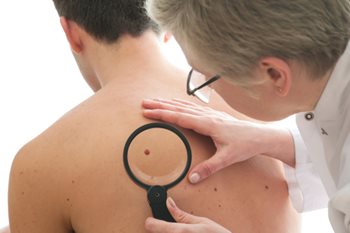Healthy Living
Skin Cancer: Are You at Risk?
Did you suffer a few blistering, lobster-red sunburns as a kid? Do you have light-colored eyes and fair skin, sprinkled with freckles? Has anyone in your family had the type of skin cancer known as melanoma?
While no one is risk-free when it comes to skin cancer, the stakes may be higher for you if you answered “yes” to any of those questions.

When it comes to protecting your skin from cancer, you can’t be too safe, according to UR Medicine dermatologist Dr. Marc Brown. Each year, there are more new cases of skin cancer than breast, prostate, lung, and colon cancers combined, according to the American Center Society. Fortunately, skin cancer is almost always curable if caught early.
There are three types of skin cancer: basal cell, squamous cell, and melanoma. While each calls for medical attention, melanoma is the most serious as it is the type of skin cancer most likely to spread to other parts of the body if left untreated.
Protect Yourself
A few simple steps can help you avoid some of the more serious consequences of skin cancer.
- Sun screen: Take steps to protect yourself from sun exposure, like using sun screen, wearing a hat and protective clothing, and avoiding the sun when it is most intense. Click here for more sun-safety tips.
-
Skin screen: Once a month, do a careful check of your skin, paying special attention to any moles you have. Check for new moles and changes in existing moles. Follow the skin-check ABCs, and look for:
- Asymmetry—does is lack balance in its shape or size?
- Border irregularity—are its edges jagged?
- Color changes—has the shade of it changed or does it bleed?
- Diameter growth—is it bigger?
- Evolution—has it changed in any other way?
If you notice any changes, it’s a good idea to have your health provider take a look. Early detection of skin cancer can be a life-saver.

Marc Brown, M.D., is a professor of Dermatology who specializes in the diagnosis, treatment and prevention of skin cancers. In addition to performing Mohs surgery on more than 1,200 patients a year, he also runs a multidisciplinary melanoma group practice.

